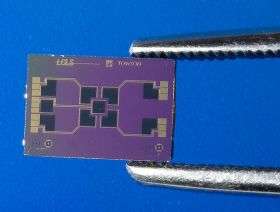The LCLS total energy sensor will sit directly in the X-ray beam during commissioning to help calibrate diagnostic equipment. Photo by Brad Plummer
The Linac Coherent Light Source will generate X-rays 10 billion times brighter than any source before it. Being the first of its kind, the LCLS has presented engineers with a number of unique technical hurdles. Measuring just how much punch the LCLS beam actually packs has proved especially challenging. But a team of LCLS scientists and engineers led by Stephan Friedrich at Lawrence Livermore National Laboratory has solved the problem with a tiny sensor designed to confront the beam head on.
The power contained in a single pulse from the LCLS is estimated to be in the neighborhood of a few billion watts—a tremendous amount to be sure. However, that power will be compressed into an unimaginably tiny sliver of time: around 100 femtoseconds, or one-tenth of a quadrillionth of a second. Because the pulses are so short, the total energy of the beam is relatively low, about 2 millijoules.
Despite their brevity, the momentary burst of X-rays still packs enough punch to instantaneously destroy most materials, a critical consideration for sensor design. Additionally, the sensor must be able to measure pulses at the full repetition rate of 120 per second.
Measuring X-ray beam power is typically a routine undertaking for X-ray physicists. At synchrotron labs, as with the LCLS, scientists prefer indirect measurements that don’t destroy the beam. These are usually accomplished with devices that absorb only a small part of the beam, which would otherwise taint sensitive experiments. One approach uses a device called an ionization chamber, in which the beam passes through a hollow cavity filled with a gas such as helium. The passing X-rays strip electrons from the helium atoms, generating a signal proportional to the beam energy, which gives scientists an indirect way to calculate the energy without disturbing the X-rays.
For an ionization chamber to work, researchers must first know how X-rays of different energies affect helium atoms. That has been well established in synchrotron labs. In the case of the LCLS, laser power of this magnitude has never been created. No one knows what exactly such a beam would do inside an ionization chamber.
Engineers have overcome this challenge with a new sensor that will measure the power directly by intercepting the beam. This will make the beam useless for doing science. However, the information will be used to calibrate diagnostic equipment—such as ionization chambers—during the commissioning phase of the LCLS, before scientists begin conducting experiments. Once commissioning is complete, the sensor will be retired in favor of indirect methods.
Directly calibrating ionization chambers first requires a device that can withstand the X-ray power. Friedrich's team solved the problem using a combination of commonly available materials, starting with a silicon wafer with a thermometer affixed to it. The silicon absorbs the X-rays, converts the energy to heat, and the onboard thermometer responds to that heat with a change in electrical resistance.
The device is mounted to a heat exchanger that cools the sensor back down within a few milliseconds, readying it for the next pulse. In this way, the new sensor can measure the full power of the LCLS running as designed at 120 pulses per second.
Friedrich says his team looked at a variety of different exotic materials that could withstand the X-rays, but settled on silicon because it has been thoroughly researched. "In a project like this, you don't want to reinvent the wheel," he said. "We wanted to work with a material that people have a lot of experience with and that lots of other smart people have thought about. Silicon is a great example."
Source: by Brad Plummer, SLAC
























